In defense of Dino-Rama
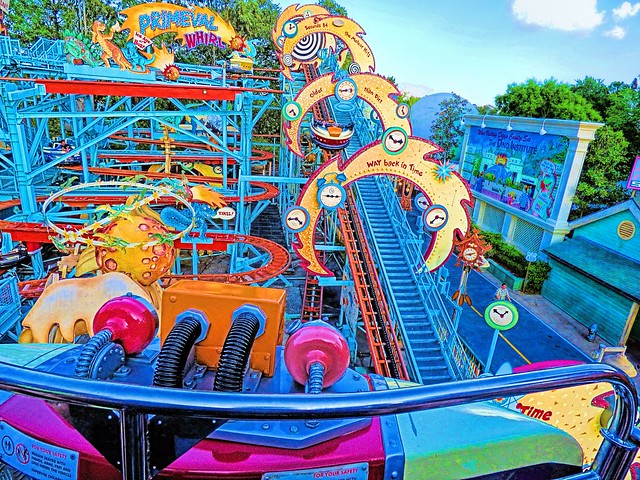
Before we get into a defense of Dino-Rama, there are two things we won’t deny:
- At first glance (and even the second), Dino-Rama feels massively out-of-place at Disney’s Animal Kingdom.
- Dino-Rama is what it looks like: a “cheap-and-cheerful” way of bolstering Animal Kingdom’s family friendliness and ride count with quick, off-the-shelf carnival rides – art imitates life!
But in all fairness, those same two points can also be lodged against “a bug’s land,” Pixar Pier, and Toy Story Land – lightly-themed areas packed with carnival rides, with the latter becoming a standard at almost every Disney Resort on Earth. And believe it or not, Dino-Rama might have the best embedded narrative of all three… Bear with us…
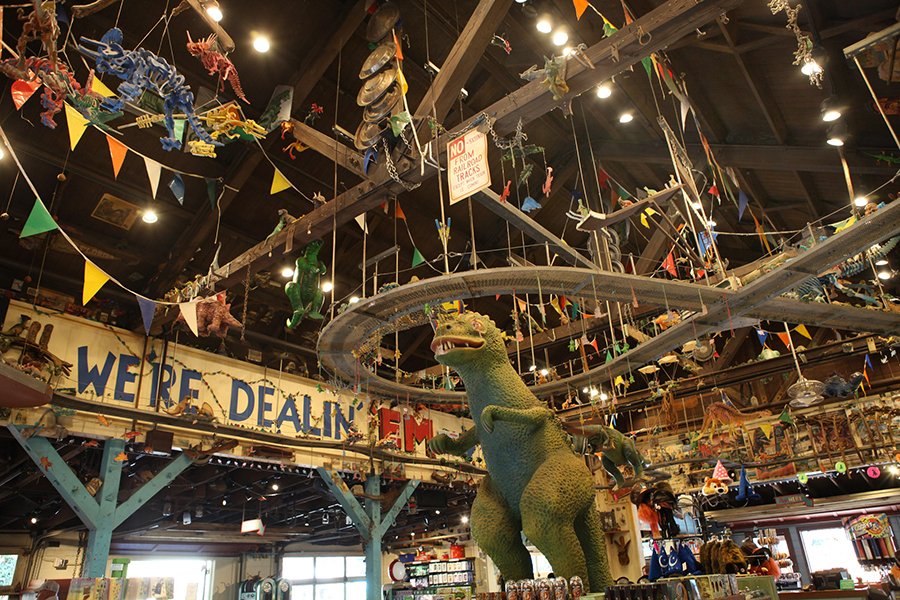
Since Animal Kingdom’s opening, the story of Chester & Hester has been wrapped into Dinoland as representatives of the “local” point-of-view. This couple – the long-time proprietors of the service station in Diggs County – were the first to cash-in on the dino-craze that moved in in the ‘40s and ‘50s. Even in 1999, guests in Dinoland could see their fossil-finding handiwork, with their dino-emblazoned Sinclair gas pumps long since rusted and their gas station retrofitted into a purposefully-playful, strategically-tacky “visitors center” advertising “DIRT CHEAP” souvenirs and meteor-painted “GOING OUT OF EXISTENCE SALE – EVERYTHING MUST GO!” billboards.
That shop – Chester & Hester’s Dinosaur Treasures – even displays an old-time photograph of Chester & Hester at their station’s opening, proudly holding aloft their first dollar in a frame. (That, by the way, is the kind of world-building you only expect from Disney’s best classic lands, and new-age favorites like Buena Vista Street or Galaxy’s Edge.)
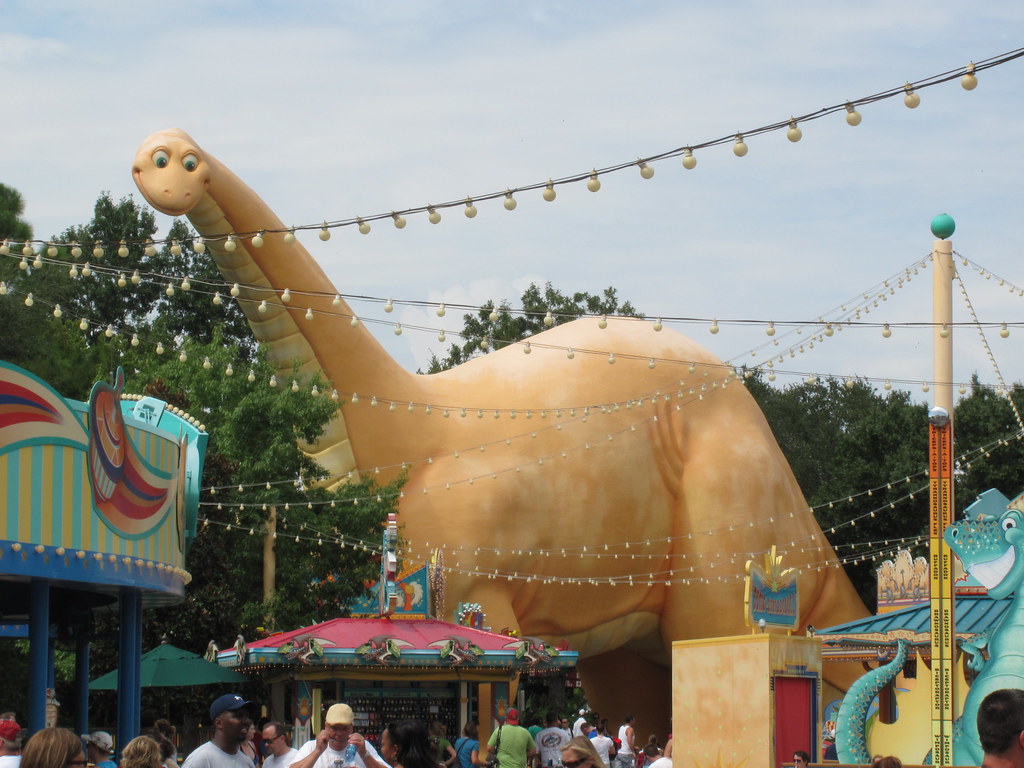
Surely, in isolation, this obtrusively-adorned gift shop was comprehensible as a tongue-in-cheek representative of Diggs County’s story; a historic building with layers and layers of detail added to it as “Dinoland’s” tourism ebbed and flowed. But in 2002, the story was “retconned.” Now, Chester & Hester and their newfound wealth would purchase a parking lot just on the other side of Highway 498, bringing in a series of traveling fair rides to build their own dino-carnival for tourists.
In keeping with the story, Chester & Hester’s Dino-Rama is not a charmingly mid-century attraction (which might’ve read better). Instead, it’s full-blown 2002: an oversaturated cartoon carnival of smiling dinosaur cutouts, massive concrete creatures, and buzzing, ringing, and flashing midway games.
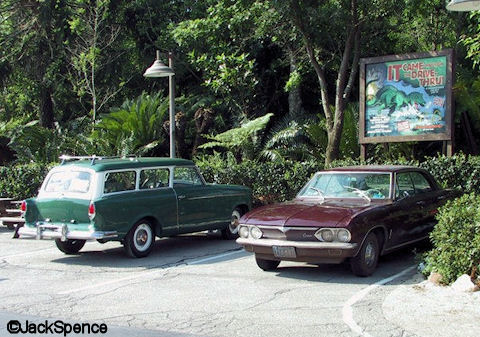
Sure, if you’re willing to look closely (as AllEars’ Jack Spence did), you’ll see quaint ‘50s details like planters ringed with old service station tires, reclaimed license plates painted over with directional signs, and – at one time – a parking lot with prop sedans. Even the “cementosaurus” is supposed to convey the time-honored tradition of roadside icons (think, “the world’s largest ball of yarn!”) meant to lure tourists in.
Perhaps the ultimate evidence of just how masterfully designed Dino-Rama is meant to be is – of all things – the much-maligned “asphalt parking lot” it’s built on. Even Imagineering fans have been known to spread the rumor that Disney literally built Dino-Rama on a bit of leftover, broken bit of the park’s parking lot – the kind of expansion site you’d expect of a ’90s Six Flags.

The truth is, Imagineers painstakingly created that cracked blacktop… In fact, since Florida’s climate is simply too hot and wet for real asphalt, the parking lot was carved of scenic concrete to appear like cracked blacktop. The same art form and process that created Natural Wonders of the Theme Park World – like Cars Land’s Cadillac Range or Batuu’s Black Spires – also formed that parking lot…
Explaining the joke
But think of it this way – of all of Disney’s “cheap and cheerful” lands, Dino-Rama not only has the best excuse to exist within its land’s story; it’s also deeply tied to the heart of Animal Kingdom. If Animal Kingdom is about the intrinsic value of nature and how humanity has shaped itself around the world we inhabit, then maybe – just maybe – “Dino-Rama” is a piece of the story of dinosaurs…
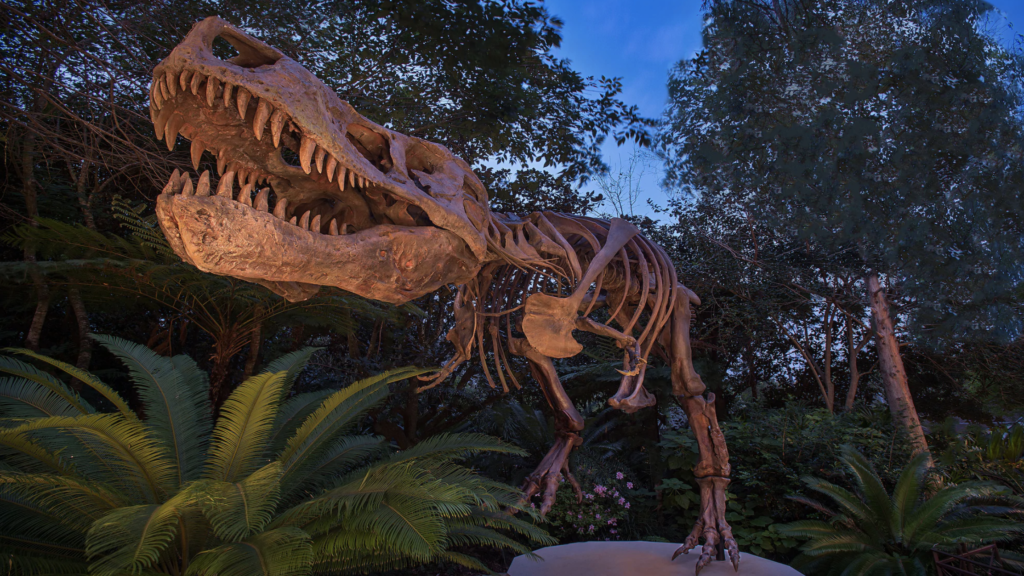
Just as Anadapur’s misty temples have been made a sanctuary for wildlife, or Pandora’s bioluminescent jungles are overtaking the militaristic remains of human interference, perhaps the way dinosaurs intermingle with the human story is here; as attractions; as marvels; as bones that have literally created entire tourist towns; as the unfathomable idea that giant feathered lizards once walked the earth, so incomprehensible that they’ve become characters in our children’s minds, dancing across pajamas and TV screens.
The dichotomy of Dinoland’s story – half stoic academia, half outrageous evolving pop culture – isn’t so different from the real story of dinosaurs. And that’s the point. Dinoland is intentionally a land that relishes in our cultural fascination with the incomprehensible reality of dinosaurs and our fetishization of them as characters in media.
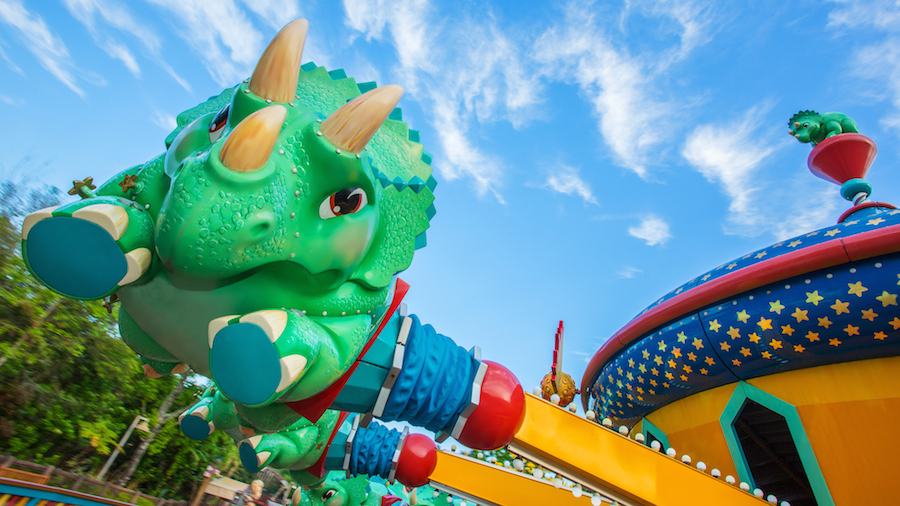
There’s no doubt that Imagineers – tasked with quickly and cheaply increasing family capacity at Animal Kingdom – took the bull by the proverbial horns, finding a way to both fulfill the brief and expand on Dinoland’s exploration of our modern relationship with long-extinct reptiles. Their built-in excuse – to pull from and expand on the land’s existing frame story – is nothing if not admirable! But it’s also lost on most guests.
To decisively end our defense of Dino-Rama, we really have to turn to a quote from E.B. White – “Explaining a joke is like dissecting a frog. You understand it better, but the frog dies in the process.”
If a story’s being told but no one hears it, is it really being told? More to the point, if a historian, a paleontologist, an anthropologist, and a folk arist need to explain the story to you to have it make sense, perhaps it’s not being told as well as you thought…
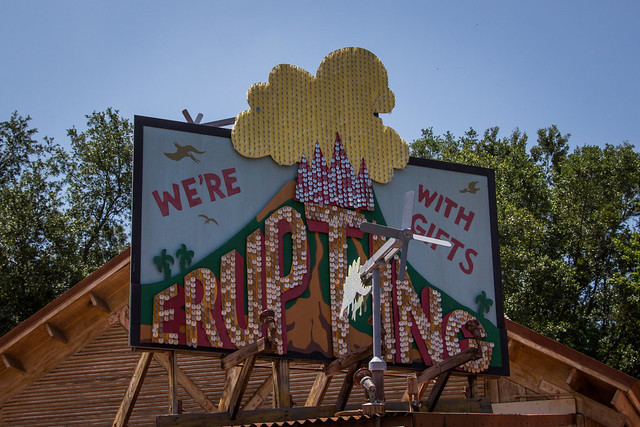
Though we argue that there may be more intention and artistic integrity to Dinoland and Dino-Rama that most visitors ever notice, the fact that most guests never notice it is precisely the issue… In more ways than one, Dino-Rama falls neatly into one of our Tell-Tale Signs of a “Bad” Theme Park Story. So while our half-hearted defense of Dino-Rama ends here, the story of the mini-land hasn’t quite yet…
Extinction Event
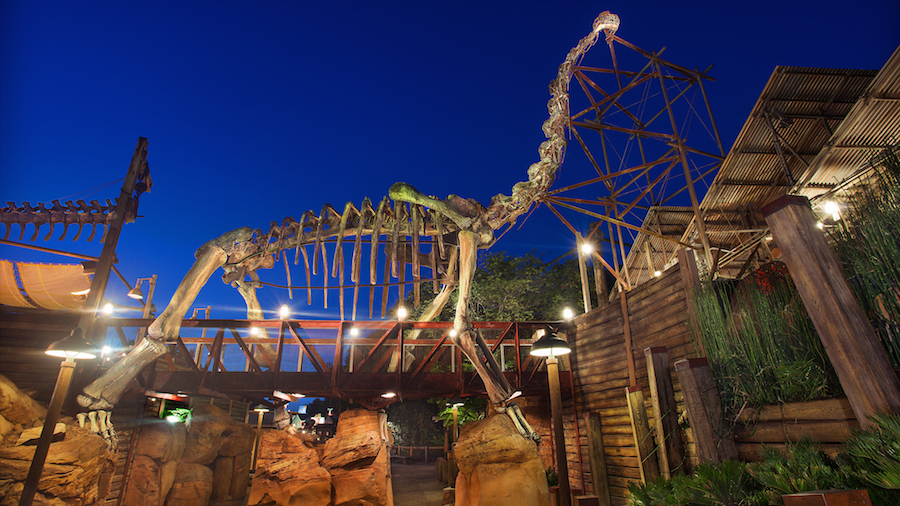
Since the earliest days of Disney’s Animal Kingdom, fans have hotly debated what the future of Dinoland might hold. Even here at Park Lore, we dedicated a rare Editorial to opining on past, present, and future of Dinoland. Surely you can see why.
In no small part, the last three decades have seen dinosaurs come, go, and come again from pop culture, but always by way of intellectual properties outside of Disney’s control – Jurassic Park, The Land Before Time, and Jurassic World. (Disney’s attempts – 2000’s Dinosaur, 2002’s Dinotopia mini-series, and 2015’s The Good Dinosaur all largely flopped.)

Surely Disney would love to graft IP onto Dinoland, but the closest they can get is an odd, quasi-permanent “Donald Duck’s Dino-Bash” celebrating Donald’s recent discovery that he’s a descendant of dinosaurs. The 2018 event added more visual clutter, irreverence, and chaos to the land, much of it more loud, brash, and nonsensical than Dino-Rama had been to begin with. Of course, adding walkaround Disney characters into the mix also served to further dillute any semblance of the land’s embedded story that guests could pick up.
Well beyond the scope of this entry, the land’s anchor attraction – the Modern Marvel: DINOSAUR – never became the fan-favorite Eisner hoped (for reasons we explored in that full, standalone feature). Most notably, the ride will forever be unfavorably compared the Indiana Jones attraction it’s technically a nearly-identical clone of… a ride Disney’s Animal Kingdom is so close to having but for swapped set dressings…
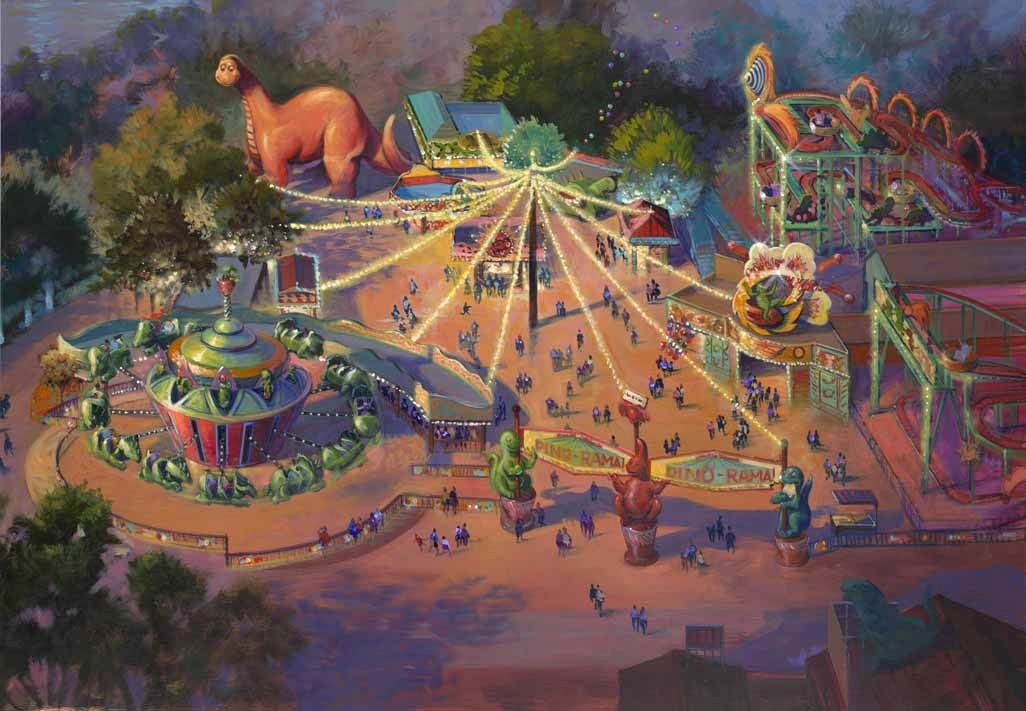
And then there was Dino-Rama. Though armchair Imagineers waxed poetic on the potential end of Dino-Rama or even the entire Dinoland, it was mostly fan fodder; creative Blue Sky think-alouds on discussion boards… Until it started to seem possible…
After years of technical dificulties (mostly due to the bankruptcy of its manufacturer, Reverchon) and involvement in two separate Cast Member deaths, in 2019 Primeval Whirl was switched to “seasonal” status – in Disney Parks lingo, a common indication that “the end is near.” The promise of only operating when seasonal crowds required it is one thing for a restaurant or show; but for a steel roller coaster looming over Dinoland?

It didn’t stay “seasonal” for long. On July 16, 2020 – in the midst of the global COVID-19 pandemic that reduced park capacity, kept Disney Parks across the globe closed entirely, and saw a total economic and healthcare collapse in the United States – Disney officials confirmed that Primeval Whirl would never re-open.
Which means that – even as Disney and its theme parks slowly crawl out of the recession that’s likely to stymie air travel, tourism, and vacationing for years – Dinoland’s carnival will be that much closer to actually being the abandoned parking lot it’s often been labeled. Disney’s backwards-engineered ode to our enduring fascination with dinosaurs just may go the way of its subject matter: extinction.
Life imitates art

If you ask most fans of Imagineering, Animal Kingdom is an absolute pinnacle of the power of themed design. The Oasis, Pandora, Asia, Africa, and Discovery Island feel so incredibly real that guests simply gaze in awe at the layers upon layers of life built into the villages, towns, and outposts each contains. The exceptional photorealism of these lands means that – for most guests – there’s no “deep dive” necessary; a casual glance is enough to convince the mind and heart that these lands are “real” and loaded with centuries of detail, and to simply accept that every single detail must’ve been authentic.
Despite popular belief, that same intense level of realism is behind Dino-Rama, too. But in this particular case, Disney may have hidden the story too well and, in their quest for realism, overshot the goal. Imagineers so perfectly crafted the feeling of a cheap-and-cheerful roadside amusement park, most guests (and even fans) give the land a cursory glance and arrive at a logical conclusion: that Disney cheaped out and built dino-dressed carnival rides. Even tried-and-true Disney Parks aficionados are known to balk that Disney built part of Dinoland on a reclaimed bit of parking lot… Apparently not realizing the effort that went into making that parking lot! (In fact, visit AllEars.net for even more amazing Dinoland details…)
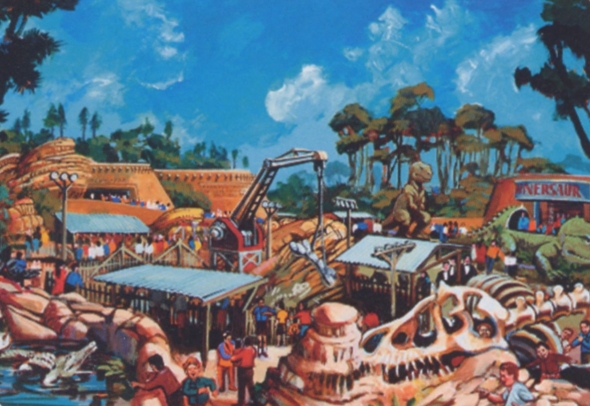
And to be fair, Dinorama was cheap and is cheerful; a relatively low-cost way to add much-needed family capacity to the park. Like Disney California Adventure’s “a bug’s land” or Hollywood Studios’ Toy Story Land, the choice of a lightly-dressed carnival was no accident, but a budget-conscious way of expanding the park’s offerings and family appeal. We won’t debate that the inclusion of boardwalks, backlots, and carnivals in Disney Parks is a justified frustration for fans who see them as creative cop-outs.
But next time you visit Dinoland and its Dinorama, consider that there’s more than may initially meet the eye to the land. In fact, it’s layered in decades worth of story… if you’re willing to dig…

Thank you so much for reading. Now, it’s your turn to join the story. If you enjoy spending time falling down the “rabbit hole” of Park Lore’s in-depth, ad-free, member-supported stories, consider becoming a Member for as little as $2 / month.
Members can unlock rare concept art in every tale, reveal attraction audio streams in select stories, gain access to over a hundred exclusive articles in our quick-read Extra Features and in-depth Special Features collections, gain exclusive podcast extras, and receive an annual member card and merch in the mail! (Plus, y’know, supporting research-based, ad-free, clickbait-free, in-depth theme park writing!)


